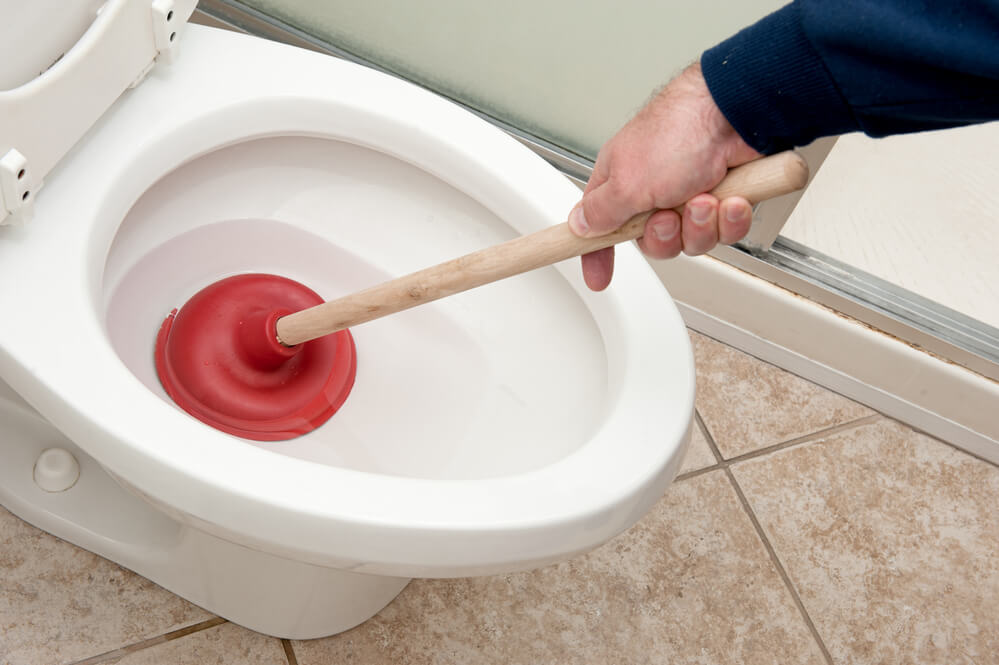How to unblock a toilet without a plunger?


It always happens when you are busy and you least expect it! Having said that, I don’t think that there is a good time for your toilet to get blocked – especially if you never got around to buying a plunger or, because you need it, you just can’t find it! According to West London Plumbers, plumbers in West London, there are some effective ways to unblock the toilet without using a plunger and, if one method doesn’t work, another one may well be successful! Before you try any of them though, it is worth turning the water off or at least raising the ballcock to ensure no further water flows into the toilet as the level is probably already high.
The classic method.
The first step is to squirt a generous amount of washing up liquid or shampoo down the toilet pan as this will lubricate the pipe and help the toilet paper slide down. When you have done this, pour a gallon (bucketful) of hot (but not boiling) water into the toilet from waist height as this makes the flow of water more powerful to help dislodge the blockage. Make sure though that the water is not boiling as this could cause the toilet bowl to crack.
After a good five minutes, the water should have successfully broken down the toilet paper in the pipe and the slippery surface will have helped the paper slide down the pipe – success! If this method is working, you may well notice the water level in the toilet starting to drop after a couple of minutes- definitely a good sign!
Try the fizzy solution!
This is another simple method that works well if the toilet tissue is not too compacted. Pour a teacup of baking soda into the toilet. Next, slowly pour two cups of vinegar into the toilet – do this carefully as there will be a chemical reaction between the two and the water will fizz and froth. Leave for about 30 minutes to give the solution time to work its magic by disintegrating the toilet paper.
Use the toilet brush like a plunger.
This method can work well, although it usually involves the toilet brush needing a really good clean afterward! Holding the toilet brush by the handle, push the brush down as far as it will go and give a few quick, strong pumps to see if you can loosen the blockage.
Success with a plastic bottle!
It sounds strange but this method can also work well- although it can prove to be a little messy. The key to success is to empty the toilet pan of as much water first- using a small container. You will then need an empty one-liter plastic bottle filled with warm water. Keep your finger firmly on the top of the bottle, to keep the warm water in. Quickly invert the bottle (keeping your finger in place) and put the bottle into the water outlet pipe at the bottom of the toilet. Squeeze the bottle firmly several times so that the water shoots out – hopefully unblocking your toilet. This method is clearly shown in this video https://www.youtube.com/watch?v=jn3y5Lwpb2Y
Make yourself a DIY toilet snake!
For more severe blockages of the pipe in your toilet, you may well find that the water and soap method doesn’t work.
You will need to get a strong wire coat hangar and carefully straighten it out with pliers into a long straight piece of sturdy wire. Push one end of the wire into the clogged toilet paper and then keep prodding until the paper frees and flows down the water pipe. Do be careful when prodding the blockage as it is possible to scratch the toilet pan with the metal.
They say prevention is better than cure!
Once you have successfully unblocked your toilet, it is well worth spending a few moments reflecting on how well the toilet is being used by all your family members. Only human waste and toilet paper should ever be flushed down the toilet. Many other items- including ever-popular baby pipes- cannot be flushed away, unless it is specifically stated on the packet. If you do not have a small pedal bin in your cloakroom, it may well be worth investing in one.
Whilst some of the more luxurious toilet tissues are lovely to use, they might not be good for the plumbing – especially if you have a septic tank. If you have young children in the house, check that they really understand what can and what can’t go be flushed down the toilet and importantly, check how much toilet paper they are using each time. The website https://theplumber.com/10-tips-for-preventing-toilet-troubles/ is interesting to read as it gives a comprehensive rundown on how to best care for your toilet…
The final essential tip is to ensure that you buy yourself a plunger next time you are in a DIY store!